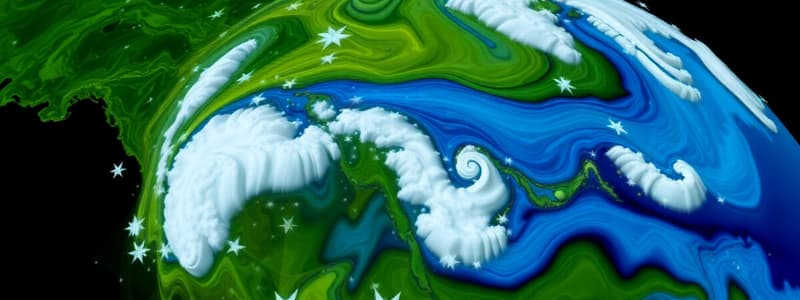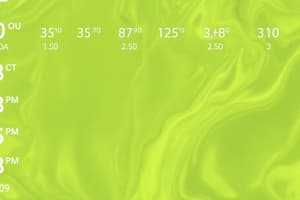Podcast
Questions and Answers
Why is collecting weather data over a long period essential for understanding atmospheric patterns?
Why is collecting weather data over a long period essential for understanding atmospheric patterns?
- It determines the exact weather conditions for specific events in the future.
- It helps identify trends and understand how the atmosphere works. (correct)
- It provides real-time temperature updates for daily activities.
- It calibrates the accuracy of individual weather measurement devices.
Which of the devices listed uses radio waves to measure weather conditions?
Which of the devices listed uses radio waves to measure weather conditions?
- Barometers
- Radar systems (correct)
- Anemometers
- Transmissometers
Which of the following pairs of instruments directly measure related aspects of wind?
Which of the following pairs of instruments directly measure related aspects of wind?
- Thermometer and barometer
- Transmissometer and barometer
- Rain gauge and hygrometer
- Wind vane and anemometer (correct)
If a transmissometer detects a significant loss of light, which weather condition is most likely present?
If a transmissometer detects a significant loss of light, which weather condition is most likely present?
How does a barometer measure atmospheric pressure?
How does a barometer measure atmospheric pressure?
A research team aims to gather comprehensive atmospheric data, including temperature, humidity, and wind speed at various altitudes. Which combination of data collection methods would be MOST effective?
A research team aims to gather comprehensive atmospheric data, including temperature, humidity, and wind speed at various altitudes. Which combination of data collection methods would be MOST effective?
A weather forecasting center needs real-time data on atmospheric humidity. Which instrument is specifically designed to measure the water content in the air?
A weather forecasting center needs real-time data on atmospheric humidity. Which instrument is specifically designed to measure the water content in the air?
During a severe storm, a weather station loses its satellite data feed. What alternative method could the station use to obtain upper-level atmospheric data, including wind speed and direction?
During a severe storm, a weather station loses its satellite data feed. What alternative method could the station use to obtain upper-level atmospheric data, including wind speed and direction?
A meteorologist wants to analyze the movement of a large storm system across a wide geographic area. Which data collection method would provide the MOST comprehensive spatial coverage?
A meteorologist wants to analyze the movement of a large storm system across a wide geographic area. Which data collection method would provide the MOST comprehensive spatial coverage?
An atmospheric scientist is evaluating the effectiveness of different weather data collection methods. Which of the following statements correctly describes a limitation of using aircraft for weather data collection compared to weather balloons?
An atmospheric scientist is evaluating the effectiveness of different weather data collection methods. Which of the following statements correctly describes a limitation of using aircraft for weather data collection compared to weather balloons?
Flashcards
Weather Data
Weather Data
Any facts or numbers about the atmosphere's state, including temperature, wind speed, precipitation, humidity, and pressure.
Thermometer
Thermometer
Measures temperature using a liquid that expands when heated and contracts when cooled (or digitally).
Radar Systems
Radar Systems
Creates maps of rain and snow by bouncing radio waves off clouds and measuring their return time.
Barometer
Barometer
Signup and view all the flashcards
Anemometer
Anemometer
Signup and view all the flashcards
Hygrometer
Hygrometer
Signup and view all the flashcards
Weather Satellites
Weather Satellites
Signup and view all the flashcards
Weather Balloons
Weather Balloons
Signup and view all the flashcards
Weather Stations
Weather Stations
Signup and view all the flashcards
Satellite Use in Weather
Satellite Use in Weather
Signup and view all the flashcards
Study Notes
- Weather data involves facts and numbers about the atmosphere's condition.
- This includes temperature, wind speed, precipitation, humidity, and pressure.
- Collecting daily weather data helps reveal patterns and trends.
- This data also helps to understand how the atmosphere functions.
Data Collection Devices
- Meteorologists use various equipment to measure weather.
- Thermometers measure temperature using liquid expansion or digital sensors.
- Radar systems map rain and snow by bouncing radio waves off clouds.
- Barometers measure atmospheric pressure, indicating air density.
- Rain gauges quantify rainfall by measuring collected water in a container.
- Wind vanes indicate wind direction using a sail pushed by the wind.
- Anemometers measure wind speed using rotating cups.
- Transmissometers measure visibility by assessing light lost through the air.
- Hygrometers measure humidity by assessing air's electrical conductivity.
Satellites, Balloons, Aircraft, and Stations
- Satellites orbiting Earth measure cloud size, motion, and precipitation using cameras and radar.
- Weather balloons measure pressure, temperature, humidity, and wind speed, drifting with the wind.
- Aircraft measure weather similarly to balloons, excluding wind speed.
- Weather stations on the ground house weather data collection devices.
- Weather stations coordinate data from satellites, aircraft, and balloons.
- Combined data collection methods provide a comprehensive view for understanding and predicting weather.
Studying That Suits You
Use AI to generate personalized quizzes and flashcards to suit your learning preferences.




